Ruoming Jin
Kent State University
Evaluating LLM Alignment on Personality Inference from Real-World Interview Data
Sep 16, 2025Abstract:Large Language Models (LLMs) are increasingly deployed in roles requiring nuanced psychological understanding, such as emotional support agents, counselors, and decision-making assistants. However, their ability to interpret human personality traits, a critical aspect of such applications, remains unexplored, particularly in ecologically valid conversational settings. While prior work has simulated LLM "personas" using discrete Big Five labels on social media data, the alignment of LLMs with continuous, ground-truth personality assessments derived from natural interactions is largely unexamined. To address this gap, we introduce a novel benchmark comprising semi-structured interview transcripts paired with validated continuous Big Five trait scores. Using this dataset, we systematically evaluate LLM performance across three paradigms: (1) zero-shot and chain-of-thought prompting with GPT-4.1 Mini, (2) LoRA-based fine-tuning applied to both RoBERTa and Meta-LLaMA architectures, and (3) regression using static embeddings from pretrained BERT and OpenAI's text-embedding-3-small. Our results reveal that all Pearson correlations between model predictions and ground-truth personality traits remain below 0.26, highlighting the limited alignment of current LLMs with validated psychological constructs. Chain-of-thought prompting offers minimal gains over zero-shot, suggesting that personality inference relies more on latent semantic representation than explicit reasoning. These findings underscore the challenges of aligning LLMs with complex human attributes and motivate future work on trait-specific prompting, context-aware modeling, and alignment-oriented fine-tuning.
SoK: Are Watermarks in LLMs Ready for Deployment?
Jun 05, 2025Abstract:Large Language Models (LLMs) have transformed natural language processing, demonstrating impressive capabilities across diverse tasks. However, deploying these models introduces critical risks related to intellectual property violations and potential misuse, particularly as adversaries can imitate these models to steal services or generate misleading outputs. We specifically focus on model stealing attacks, as they are highly relevant to proprietary LLMs and pose a serious threat to their security, revenue, and ethical deployment. While various watermarking techniques have emerged to mitigate these risks, it remains unclear how far the community and industry have progressed in developing and deploying watermarks in LLMs. To bridge this gap, we aim to develop a comprehensive systematization for watermarks in LLMs by 1) presenting a detailed taxonomy for watermarks in LLMs, 2) proposing a novel intellectual property classifier to explore the effectiveness and impacts of watermarks on LLMs under both attack and attack-free environments, 3) analyzing the limitations of existing watermarks in LLMs, and 4) discussing practical challenges and potential future directions for watermarks in LLMs. Through extensive experiments, we show that despite promising research outcomes and significant attention from leading companies and community to deploy watermarks, these techniques have yet to reach their full potential in real-world applications due to their unfavorable impacts on model utility of LLMs and downstream tasks. Our findings provide an insightful understanding of watermarks in LLMs, highlighting the need for practical watermarks solutions tailored to LLM deployment.
FedX: Adaptive Model Decomposition and Quantization for IoT Federated Learning
Apr 19, 2025Abstract:Federated Learning (FL) allows collaborative training among multiple devices without data sharing, thus enabling privacy-sensitive applications on mobile or Internet of Things (IoT) devices, such as mobile health and asset tracking. However, designing an FL system with good model utility that works with low computation/communication overhead on heterogeneous, resource-constrained mobile/IoT devices is challenging. To address this problem, this paper proposes FedX, a novel adaptive model decomposition and quantization FL system for IoT. To balance utility with resource constraints on IoT devices, FedX decomposes a global FL model into different sub-networks with adaptive numbers of quantized bits for different devices. The key idea is that a device with fewer resources receives a smaller sub-network for lower overhead but utilizes a larger number of quantized bits for higher model utility, and vice versa. The quantization operations in FedX are done at the server to reduce the computational load on devices. FedX iteratively minimizes the losses in the devices' local data and in the server's public data using quantized sub-networks under a regularization term, and thus it maximizes the benefits of combining FL with model quantization through knowledge sharing among the server and devices in a cost-effective training process. Extensive experiments show that FedX significantly improves quantization times by up to 8.43X, on-device computation time by 1.5X, and total end-to-end training time by 1.36X, compared with baseline FL systems. We guarantee the global model convergence theoretically and validate local model convergence empirically, highlighting FedX's optimization efficiency.
Can Large Language Models Understand Intermediate Representations?
Feb 07, 2025Abstract:Intermediate Representations (IRs) are essential in compiler design and program analysis, yet their comprehension by Large Language Models (LLMs) remains underexplored. This paper presents a pioneering empirical study to investigate the capabilities of LLMs, including GPT-4, GPT-3, Gemma 2, LLaMA 3.1, and Code Llama, in understanding IRs. We analyze their performance across four tasks: Control Flow Graph (CFG) reconstruction, decompilation, code summarization, and execution reasoning. Our results indicate that while LLMs demonstrate competence in parsing IR syntax and recognizing high-level structures, they struggle with control flow reasoning, execution semantics, and loop handling. Specifically, they often misinterpret branching instructions, omit critical IR operations, and rely on heuristic-based reasoning, leading to errors in CFG reconstruction, IR decompilation, and execution reasoning. The study underscores the necessity for IR-specific enhancements in LLMs, recommending fine-tuning on structured IR datasets and integration of explicit control flow models to augment their comprehension and handling of IR-related tasks.
Leveraging Large Language Models to Analyze Emotional and Contextual Drivers of Teen Substance Use in Online Discussions
Jan 23, 2025



Abstract:Adolescence is a critical stage often linked to risky behaviors, including substance use, with significant developmental and public health implications. Social media provides a lens into adolescent self-expression, but interpreting emotional and contextual signals remains complex. This study applies Large Language Models (LLMs) to analyze adolescents' social media posts, uncovering emotional patterns (e.g., sadness, guilt, fear, joy) and contextual factors (e.g., family, peers, school) related to substance use. Heatmap and machine learning analyses identified key predictors of substance use-related posts. Negative emotions like sadness and guilt were significantly more frequent in substance use contexts, with guilt acting as a protective factor, while shame and peer influence heightened substance use risk. Joy was more common in non-substance use discussions. Peer influence correlated strongly with sadness, fear, and disgust, while family and school environments aligned with non-substance use. Findings underscore the importance of addressing emotional vulnerabilities and contextual influences, suggesting that collaborative interventions involving families, schools, and communities can reduce risk factors and foster healthier adolescent development.
Investigating Large Language Models in Inferring Personality Traits from User Conversations
Jan 13, 2025



Abstract:Large Language Models (LLMs) are demonstrating remarkable human like capabilities across diverse domains, including psychological assessment. This study evaluates whether LLMs, specifically GPT-4o and GPT-4o mini, can infer Big Five personality traits and generate Big Five Inventory-10 (BFI-10) item scores from user conversations under zero-shot prompting conditions. Our findings reveal that incorporating an intermediate step--prompting for BFI-10 item scores before calculating traits--enhances accuracy and aligns more closely with the gold standard than direct trait inference. This structured approach underscores the importance of leveraging psychological frameworks in improving predictive precision. Additionally, a group comparison based on depressive symptom presence revealed differential model performance. Participants were categorized into two groups: those experiencing at least one depressive symptom and those without symptoms. GPT-4o mini demonstrated heightened sensitivity to depression-related shifts in traits such as Neuroticism and Conscientiousness within the symptom-present group, whereas GPT-4o exhibited strengths in nuanced interpretation across groups. These findings underscore the potential of LLMs to analyze real-world psychological data effectively, offering a valuable foundation for interdisciplinary research at the intersection of artificial intelligence and psychology.
Scalable Deep Metric Learning on Attributed Graphs
Nov 20, 2024Abstract:We consider the problem of constructing embeddings of large attributed graphs and supporting multiple downstream learning tasks. We develop a graph embedding method, which is based on extending deep metric and unbiased contrastive learning techniques to 1) work with attributed graphs, 2) enabling a mini-batch based approach, and 3) achieving scalability. Based on a multi-class tuplet loss function, we present two algorithms -- DMT for semi-supervised learning and DMAT-i for the unsupervised case. Analyzing our methods, we provide a generalization bound for the downstream node classification task and for the first time relate tuplet loss to contrastive learning. Through extensive experiments, we show high scalability of representation construction, and in applying the method for three downstream tasks (node clustering, node classification, and link prediction) better consistency over any single existing method.
Federated Contrastive Learning of Graph-Level Representations
Nov 18, 2024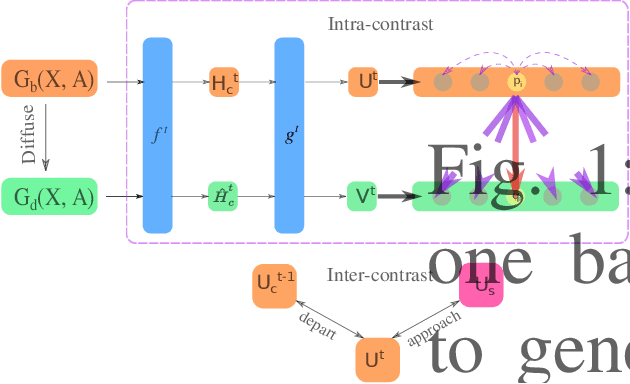
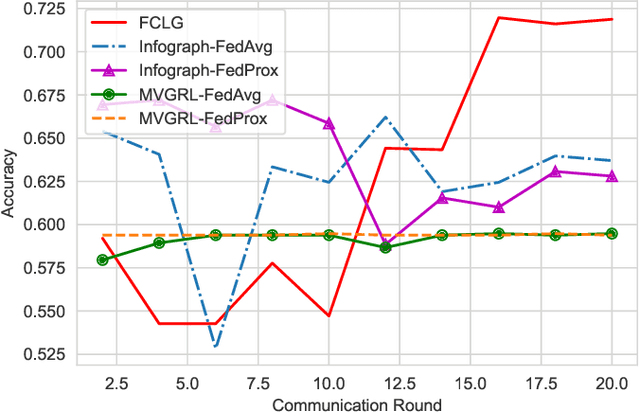

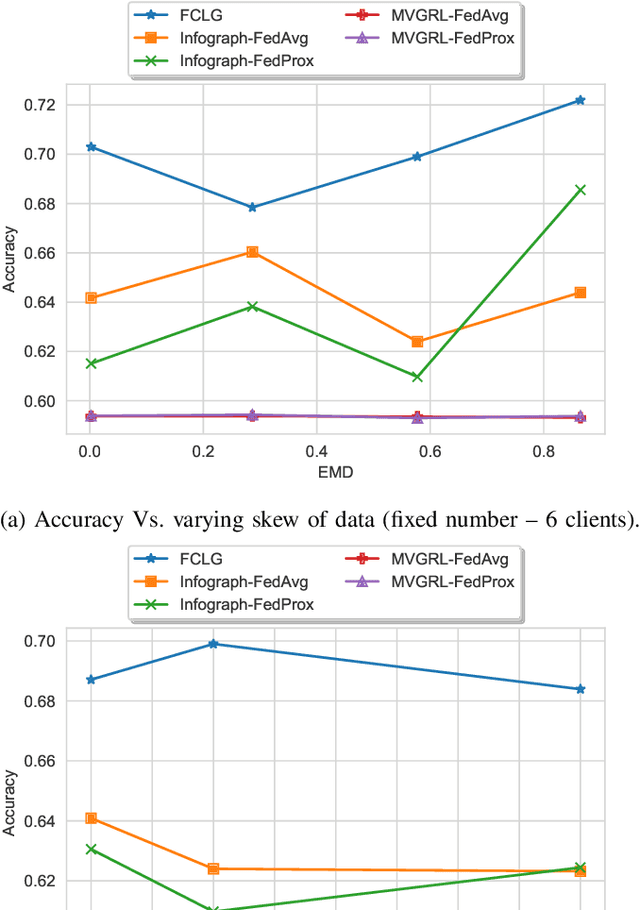
Abstract:Graph-level representations (and clustering/classification based on these representations) are required in a variety of applications. Examples include identifying malicious network traffic, prediction of protein properties, and many others. Often, data has to stay in isolated local systems (i.e., cannot be centrally shared for analysis) due to a variety of considerations like privacy concerns, lack of trust between the parties, regulations, or simply because the data is too large to be shared sufficiently quickly. This points to the need for federated learning for graph-level representations, a topic that has not been explored much, especially in an unsupervised setting. Addressing this problem, this paper presents a new framework we refer to as Federated Contrastive Learning of Graph-level Representations (FCLG). As the name suggests, our approach builds on contrastive learning. However, what is unique is that we apply contrastive learning at two levels. The first application is for local unsupervised learning of graph representations. The second level is to address the challenge associated with data distribution variation (i.e. the ``Non-IID issue") when combining local models. Through extensive experiments on the downstream task of graph-level clustering, we demonstrate FCLG outperforms baselines (which apply existing federated methods on existing graph-level clustering methods) with significant margins.
Demo: SGCode: A Flexible Prompt-Optimizing System for Secure Generation of Code
Sep 11, 2024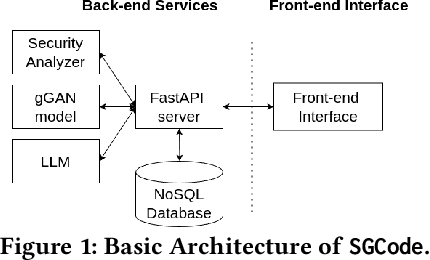

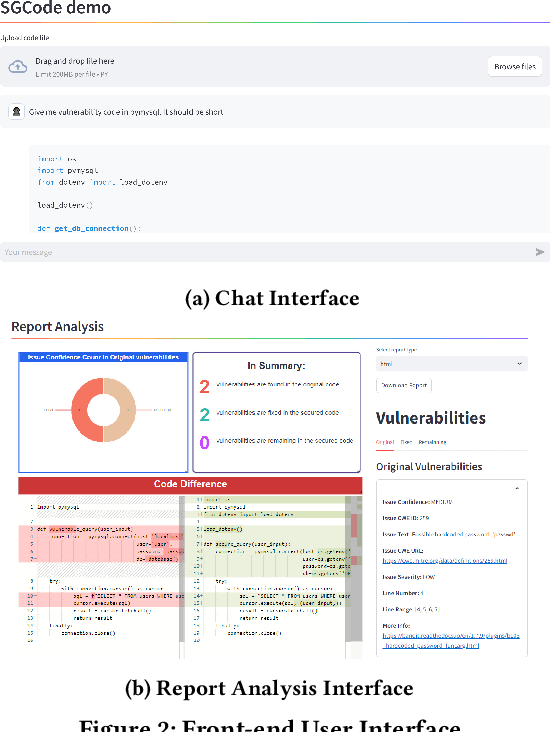
Abstract:This paper introduces SGCode, a flexible prompt-optimizing system to generate secure code with large language models (LLMs). SGCode integrates recent prompt-optimization approaches with LLMs in a unified system accessible through front-end and back-end APIs, enabling users to 1) generate secure code, which is free of vulnerabilities, 2) review and share security analysis, and 3) easily switch from one prompt optimization approach to another, while providing insights on model and system performance. We populated SGCode on an AWS server with PromSec, an approach that optimizes prompts by combining an LLM and security tools with a lightweight generative adversarial graph neural network to detect and fix security vulnerabilities in the generated code. Extensive experiments show that SGCode is practical as a public tool to gain insights into the trade-offs between model utility, secure code generation, and system cost. SGCode has only a marginal cost compared with prompting LLMs. SGCode is available at: http://3.131.141.63:8501/.
Federated Joint Learning of Robot Networks in Stroke Rehabilitation
Mar 08, 2024



Abstract:Advanced by rich perception and precise execution, robots possess immense potential to provide professional and customized rehabilitation exercises for patients with mobility impairments caused by strokes. Autonomous robotic rehabilitation significantly reduces human workloads in the long and tedious rehabilitation process. However, training a rehabilitation robot is challenging due to the data scarcity issue. This challenge arises from privacy concerns (e.g., the risk of leaking private disease and identity information of patients) during clinical data access and usage. Data from various patients and hospitals cannot be shared for adequate robot training, further compromising rehabilitation safety and limiting implementation scopes. To address this challenge, this work developed a novel federated joint learning (FJL) method to jointly train robots across hospitals. FJL also adopted a long short-term memory network (LSTM)-Transformer learning mechanism to effectively explore the complex tempo-spatial relations among patient mobility conditions and robotic rehabilitation motions. To validate FJL's effectiveness in training a robot network, a clinic-simulation combined experiment was designed. Real rehabilitation exercise data from 200 patients with stroke diseases (upper limb hemiplegia, Parkinson's syndrome, and back pain syndrome) were adopted. Inversely driven by clinical data, 300,000 robotic rehabilitation guidances were simulated. FJL proved to be effective in joint rehabilitation learning, performing 20% - 30% better than baseline methods.
 Add to Chrome
Add to Chrome Add to Firefox
Add to Firefox Add to Edge
Add to Edge